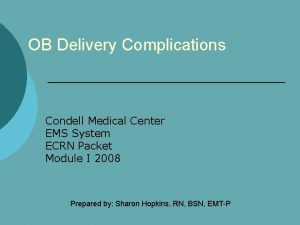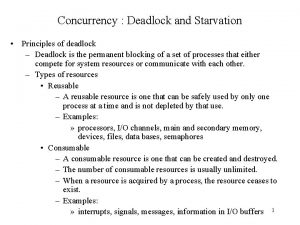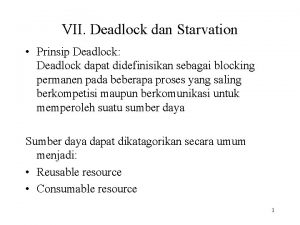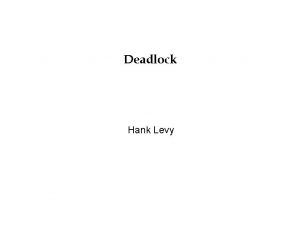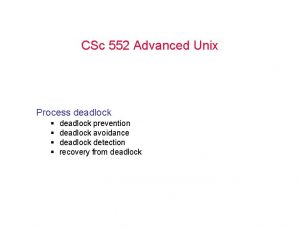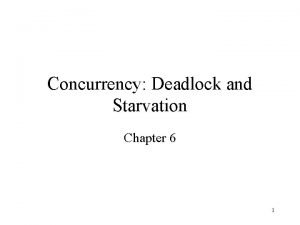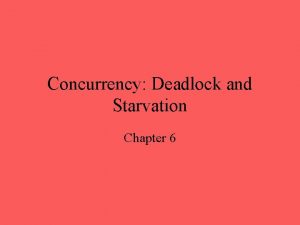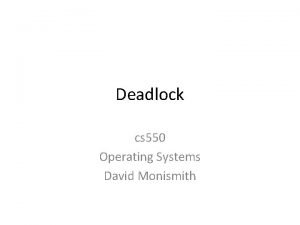DEADLOCK Contents Principles of deadlock Deadlock prevention Deadlock
















































- Slides: 48

DEADLOCK

Contents Principles of deadlock Deadlock prevention Deadlock detection

Deadlock A set of processes is deadlocked if each process in the set is waiting for an event that only another process in the set can cause.

P 1 P 2 R 1 R 2

Examples of resources: processors, I/O devices, main and secondary memory, files, emaphores…(reusable resources)

Utilization protocol request (the process can be blocked) use release

P 1 P(mutex 1); <R 1>; P(mutex 2); <R 2>; V(mutex 2); <release of R 2>; V(mutex 1); <release of R 1>;

P 2 P(mutex 2); <R 2>; P(mutex 1); <R 1>; V(mutex 1); <release of R 1>; V (mutex 2); <release of R 2>;

A deadlock situation derives from a race condition occurred to some involved processes

Conditions for deadlock P 1, P 2, … , Pn: a set of processes R 1, R 2, … , Rm: a set of resource types

A deadlock situation can arise if the following four conditions hold at the same time:

mutual exclusion hold-and-wait no preemption circular wait

All four conditions must hold for deadlock to occur

System resource allocation graph vertices: P=(P 1, P 2, . . , Pn) R=(R 1, R 2, . . , Rm) edges: request edge Pi Rj assignment edge Rj Pi

P 1 P 2 P 3 R 1 R 2 R 3

If the graph does not contains cycles, then no process is deadlocked If the graph contain one cycle, then a deadlock may exist

If each resource type has exactly one instance, then a cycle implies that one deadlock has occurred

Each process involved in the cycle is deadlocked (a cycle in the graph is a necessary and sufficient condition for the existence of a deadlock)

If each resource type has several instances, then one cycle does not necessary imply that a deadlock occurred (the cycle is a necessary but not sufficient condition)

P 3 R 1 P 1 R 2 P 2

Methods for handling deadlock We can use a protocol to ensure hat the system will never enter a deadlock state (deadlock prevention)

We can allow the system to enter a deadlock state and then recover (detection and recovery)

We can ignore the problem, and pretend that deadlocks never occur in the system It is up to the application developer to write programs that handle deadlocks

Deadlock prevention is a set of methods for ensuring that at least one of the necessary conditions can never occur

mutual exclusion It is not possible to prevent deadlocks by denying the mutual exclusion condition

hold-and- wait That condition may be prevented by requiring that each process must release all the resources currently allocated before it can request any additional resources.

no preemption If a process that it is holding same resources request another resource that cannot be immediately allocated to it, then all resources currently being held are preempted

circular wait The condition can be prevented by defining a total ordering of all resource types and by requiring that each process requests resources in an increasing order

We associate an index with each resource type Then Ri precedes Rj in the ordering if i<j

Two processes A and B, are deadlocked if A has acquired Ri and requests Rj, and B has acquired Rj and requests Ri

That condition is impossible because it implies i<j and j<i

Deadlock avoidance Deadlock-prevention algorithms prevent deadlocks by constraining the strategy on how requests can be made

Possible side effects of preventing deadlocks by these methods are an inefficient utilization of resources and an inefficient process execution

With deadlock avoidance, a decision is made dynamically whether current resource allocation requests, if granted, would potentially lead to deadlock

The resource allocation state is defined by the number of allocated and available resources and the maximum demands of processes

A safe state is one in which there is at least one process execution sequence such that all processes can be run to completion (safe sequence)

Banker’s algorithm When a process makes a request for a set of resources

assume that the request is granted, update the system state accordingly, and then determine if the result is still a safe state.

If so, grant the request, if not, block the process until it is safe to grant the request

P 2 t 8 R 1 t 7 R 2 t 6 t 5 unreachable region safe state A unsafe region safe state t 1 R t 2 1 safe state t 3 R 2 t 4 P 1

Deadlock detection It requires:

an algorithm the state of to determine deadlock has that examines the system whether a occurred an algorithm to recover from the deadlock

Recovery Possible approaches: 1. Abort all deadlocked processes

2. Back up each deadlocked process to some previously defined check points, and restart all processes form those checkpoints

3. Successively abort deadlocked processes until deadlock not longer exists 4. Successively preempt resources until deadlock not longer exists

For 3 and 4 the selection criteria could be one of the following. Choose the process with the:

Least amount of consumed processor time Least amount of produced output

Most estimated remaining time Least total resources allocated so far Lowest priority
 Primary prevention secondary prevention tertiary prevention
Primary prevention secondary prevention tertiary prevention Deadlock prevention avoidance and detection
Deadlock prevention avoidance and detection Starvation deadlock
Starvation deadlock Deadlock prevention vs avoidance
Deadlock prevention vs avoidance General principles of prevention
General principles of prevention Principles of deadlock
Principles of deadlock Zetoc
Zetoc Class contents
Class contents Ocr epq exemplar
Ocr epq exemplar Sound contents
Sound contents Contents of curriculum vitae
Contents of curriculum vitae What is vo
What is vo Tabique intermuscular vastoaductor
Tabique intermuscular vastoaductor External conflict in contents of the dead man's pocket
External conflict in contents of the dead man's pocket What nerve innervates the testicles
What nerve innervates the testicles Module 3 ctd table contents
Module 3 ctd table contents Tvmdc compass correction
Tvmdc compass correction Writing appendix in a report
Writing appendix in a report Suprasternal and supraclavicular space
Suprasternal and supraclavicular space Matlab
Matlab Science fair logbook table of contents
Science fair logbook table of contents Femoral triangle boundaries
Femoral triangle boundaries Ark of the covenant lampstand
Ark of the covenant lampstand Nature table of contents
Nature table of contents Rotator cuff interval
Rotator cuff interval Spermatocele
Spermatocele City of ember poppy
City of ember poppy What is a marketing plan
What is a marketing plan Content page magazine
Content page magazine Sphenopalatine foramen
Sphenopalatine foramen Oxygen table of contents
Oxygen table of contents Posterior mediastinum
Posterior mediastinum Contents background
Contents background Table of contents sample
Table of contents sample Febrile non hemolytic transfusion reaction
Febrile non hemolytic transfusion reaction Engineer notepad
Engineer notepad Interactive notebook table of contents
Interactive notebook table of contents Ism code contents
Ism code contents Roof of oral cavity
Roof of oral cavity Abstract vs. introduction
Abstract vs. introduction Liquefaction foci dentin
Liquefaction foci dentin Deep perineal pouch
Deep perineal pouch Ob kit contents
Ob kit contents Ramus angle
Ramus angle Quality manual contents
Quality manual contents Contents of stylistic lexis
Contents of stylistic lexis Superficial lymph nodes abdomen
Superficial lymph nodes abdomen Thigh muscles medial
Thigh muscles medial Company profile contents
Company profile contents










































